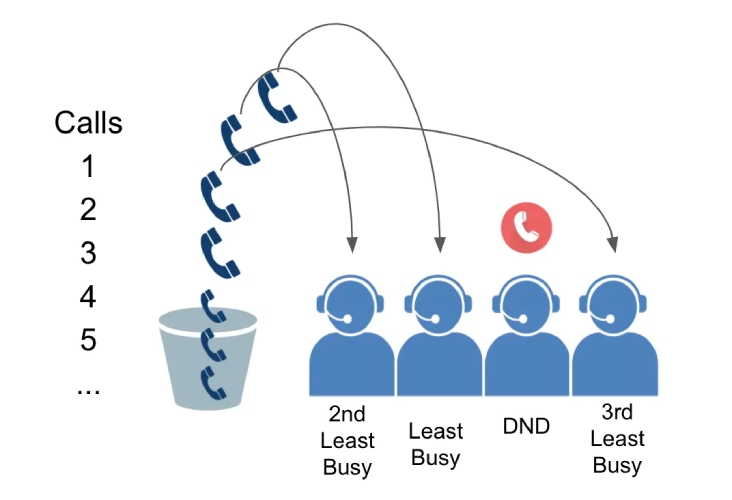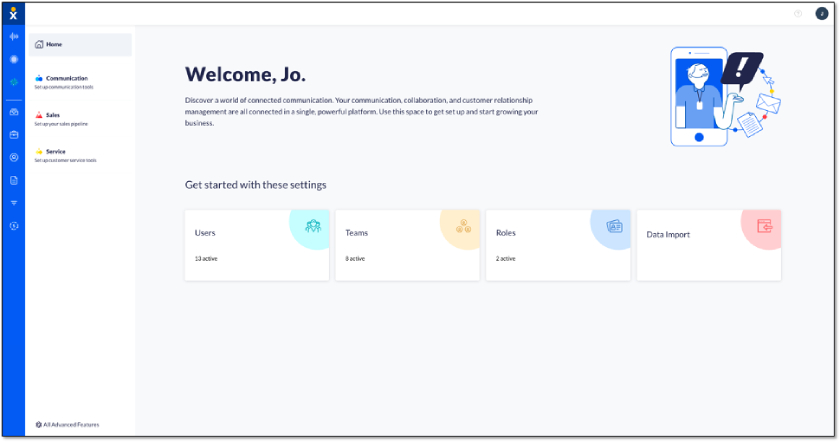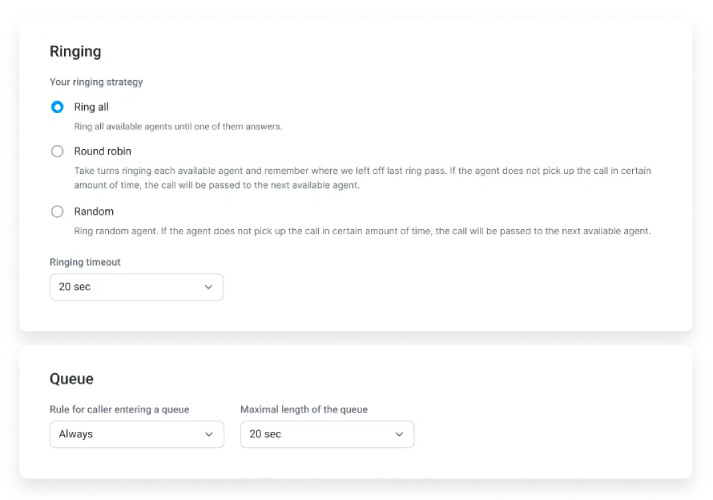Call queuing is a business phone technology that routes inbound calls by placing callers into virtual lines based on predetermined criteria. Businesses use call queues to manage call volume and minimize calling wait times—which, in turn, can improve sales, increase customer loyalty, and build stronger brand awareness. In this article, we explore what a call queue is, how it works, its benefits and best practices, and the top service providers for small businesses.
How a Call Queue Works
Here’s a quick overview of how a call queue works: A caller phones your business phone system and is greeted with a prerecorded message. The call is then routed to a virtual queue based on their response to an automated menu or conversation with your operator. Callers will speak to the next available agent when they reach the front of the queue. Businesses often set up a ring group to minimize wait time and ensure all calls are answered.
While the caller is in the queue, they often hear music, prerecorded messages about promos and updates, and their estimated wait time or queue alternatives like callback or leaving a message. Call queues enable businesses to accept simultaneous callers who “wait” to speak to you instead of being automatically disconnected.
A call queue is a phone system function that routes calls to people within your business who can help with a particular issue or question. Businesses use call queuing technology to provide better customer experiences and to ensure clients’ and potential customers’ messages won’t slip through the cracks or get buried in your voicemail inbox. The goal is to answer calls as quickly and efficiently as possible by the agent with the right skills to handle the call.
Types of Call Queues
There are several ways to route calls, the most popular being “first come, first served.” Other types of call queues for business phones include ring all, call park, and round-robin routing. All these options allow businesses to choose a routing system based on their operational capacity. Think about your schedule, operating hours, and number of agents to determine the best option.
Below are the five common call queue types:
- Round-robin: Callers are routed to the next available agent, with the system building a digital list of all users in an office. It begins ringing each available user a set number of times, moves on, and cycles back to ringing User A until the call is answered.
- Ring all: The business phone system simultaneously routes callers to all available agents.
- Linear hunt: Callers are routed to available agents in precise order. Agents’ phones ring in sequence, one after the other.
- Linear cascade: Callers are routed to groups of available agents in a predefined order.
- Call park: Calls are placed on hold until an agent retrieves them.
Best Practices & Tips for Setting Up a Call Queue
Keeping customers on hold for long periods and asking them to repeat their inquiries and concerns over and over can bog down your team and frustrate your customers. Now that you have a better understanding of what is a call queue and how it can reduce hold times, here are some tips to keep in mind when setting up your call queue:
Having a friendly greeting is excellent, but a recording that’s also informative and polished helps your business boost its credibility and set a positive tone for your customer’s journey. Avoid using a generic message by recording a personalized greeting specific to your company’s tone and branding. Include crucial information, such as your business hours, address, and frequently asked questions (FAQs), so customers are apprised of new products and updates.
Set up a schedule for how your call queue will work. For example, if you have a handful of agents from 9:00 a.m. to 6:00 p.m. on weekdays, set up the call queue system to accept calls during that period. When you don’t have agents working, direct customers to a voicemail box instead.
Interactive voice response, or what’s referred to as IVR, is an automated menu that allows customers to input their information so they’re routed to the right person. A call management service that enables customers to provide data is best because it saves valuable time and effort. IVRs and call queue tools are used in tandem because they efficiently facilitate a caller’s movement to the next destination.
Make your callers as comfortable as possible by giving them something nice to listen to while waiting. Silence can make waiting seem longer, and on-hold music helps callers relax while they wait for their turn to speak with a representative. Combine hold music and custom messaging to let callers know their place in the queue and reassure them their call is important.
Consider a voice-over-internet-protocol (VoIP) phone system with call-back features to help manage your call queue. Offering a call-back option is a great way to minimize a client’s wait time because it allows you to collect their number and call them back when it’s their turn to chat. Callers can leave the call and do other tasks, confident they’ll receive a call once an agent is available.
Benefits of Using a Call Queue
Managing your call center’s virtual queues is crucial to satisfying customers and minimizing hold times. When done correctly, it leads to a better customer experience and helps ensure fair workload distribution among your agents. See below how call queues benefit small businesses:
- Enhanced customer satisfaction: The longer customers wait, the less important they feel. Use queuing technology to get your customers the information and conversation they seek in as little time as possible. With the right messaging and feature combination, your queuing system informs customers of their queue status and estimated wait time.
- Improved first call resolution (FCR) rates: By routing callers to the right self-service option or agent immediately, businesses increase issue resolution on the first try.
- Balanced workload distribution: A proper call management system ensures that calls are distributed evenly among agents, preventing agents from being overwhelmed or overworked. Also, effective call routing reduces customer frustration, boosting employees’ work experiences.
- Increased sales: Long wait times frustrate customers and potential clients, increasing the chances they hang up and abandon your business. Establishing a quick and efficient call queuing process lowers your rate of lost callers.
Top Call Queue Providers
Phone system providers with call queue software help businesses manage customer calls. The best solutions offer a suite of call management services, such as automatic callbacks, hold music, and remote call routing. If you’re looking for a phone system offering a range of voice-over-internet-protocol (VoIP) features, including virtual queuing, consider our top-recommended options below:
Frequently Asked Questions (FAQs)
Call queue management tools aim to manage waiting times, but if teams are untrained or need more staff members, this will lead to long queues. You can address these issues by hiring more staff, outsourcing tasks, or reviewing your IVR call flow.
If you’re wondering what is a call queue and how it differs from an auto-attendant, here’s what you need to know: call queues are virtual waiting rooms that line up customers when agents are unavailable to take a call. On the other hand, an auto-attendant is a virtual answering service that allows customers to choose the extension, agent, or department they wish to speak with.
Call queues help manage inbound calls, decrease customer wait times, and improve your team’s issue resolution rates. Call queues also help you monitor call center performance and route calls efficiently between agents, reducing burnout. These benefits lead to more satisfied customers and employees.
Bottom Line
Now that we’ve answered the question, “What is a call queue?” and explained the benefits for businesses of all sizes, the next step is to ensure the effectiveness of your phone system. Call queuing places inbound callers into one or more virtual queues so your team can ensure callers are efficiently directed to the right person. Choose a provider with robust VoIP phone service features like automated callback and on-hold music to complement your call queue strategy.




